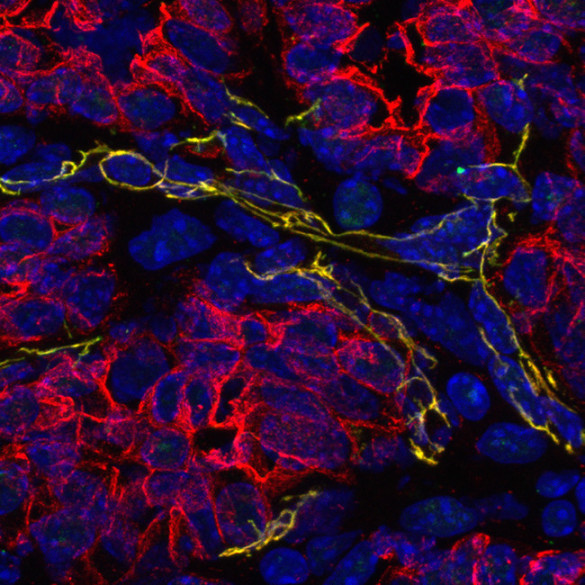
Normally, the glue that holds cells together in the human body – what scientists call the extracellular matrix – is soft and pliable. But when a metastatic tumor forms it causes the matrix surrounding it to stiffen.
According to a new study, this mechanical effect produces changes in the blood vessels that feed the tumor in a way that can reduce the effectiveness of chemotherapeutics and radiation treatments. The finding suggests that softening this protective layer could make existing cancer treatments more effective.
The study was published Dec. 22 in the Proceedings of the National Academy of Sciences, by a team of researchers led by Vanderbilt Professor of Biomedical Engineering Cynthia Reinhart-King, which includes postdoctoral researcher François Bordeleau in the Reinhart-King group along with collaborators from Cornell University. The report is titled “Matrix Stiffening Promotes a Tumor Vasculature Phenotype.”
For years, the idea has been that the way to treat tumors was to starve them by killing off their blood vessels. While that works in some cases, in others it only serves to make the tumor more aggressive, Reinhart-King said, adding: “There are ways tumors can grow in the absence of those nutrients, and they get more aggressive. At the same time, they may also stop responding to some chemotherapeutics and radiation treatments.”
A metastatic tumor’s blood vessels tend to be malformed and more permeable than blood vessels in healthy tissue. For this reason, fluid tends to leak from the vessels, building up pressure inside the tumor that prevents drugs from getting to their target.
“Basically, as fluid leaks out of the blood vessels, it causes high pressures to build up in the tumor. These high pressures can cause blood flow to stall or even reverse and vessels tocollapse,” Reinhart-King said. “So fluid, including the drugs, cannot reach the tumor tissue.”

Unlike in previous work in this area, Reinhart-King and Bordeleau see the vascular breakdown as a product of the stiffening of the tumor and its matrix, which triggers proteins in cells to alter vascular growth and integrity. Previous work has targeted chemical factors, in particular vascular endothelial growth factor.
“The idea that you would want to restore barrier integrity and help blood vessels is not a new one,” Reinhart-King said. “The idea that we discovered is that it’s controlled through matrix stiffness.” This, in turn, suggests that promoting healthy vasculature through a softening of the extracellular matrix would use the tumor itself as a conduit for delivering cancer-killing drugs.
“What we show,” Reinhart-King said, “is that we can drive a lot of the same behaviors that are typically thought to occur due to chemical changes, by changing the mechanical properties of the tumor.”
This work was supported by National Institutes of Health grants R01-HL127499 and R01-CA163255 and National Science Foundation awards 1055502 and 435755.
Based on an article in the Cornell Chronicle: http://news.cornell.edu/stories/2017/01/softening-tumor-tissue-could-aid-cancer-drug-delivery














